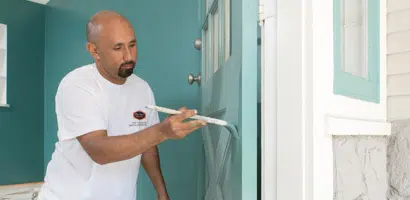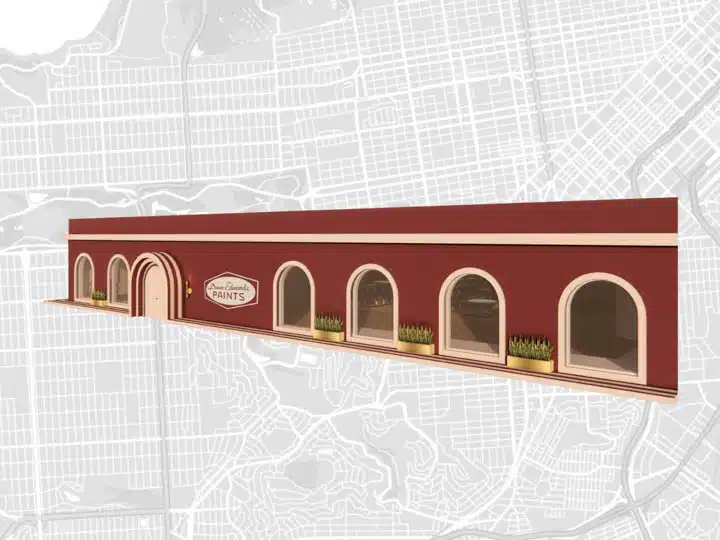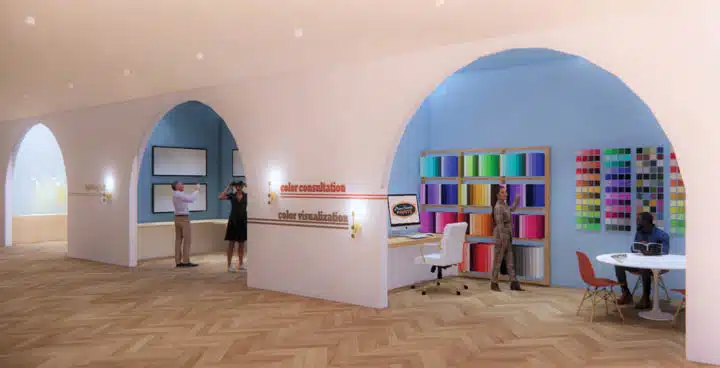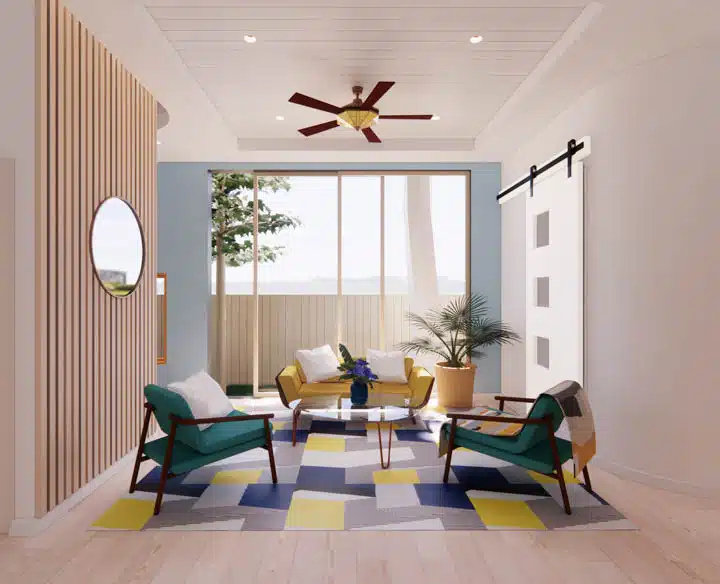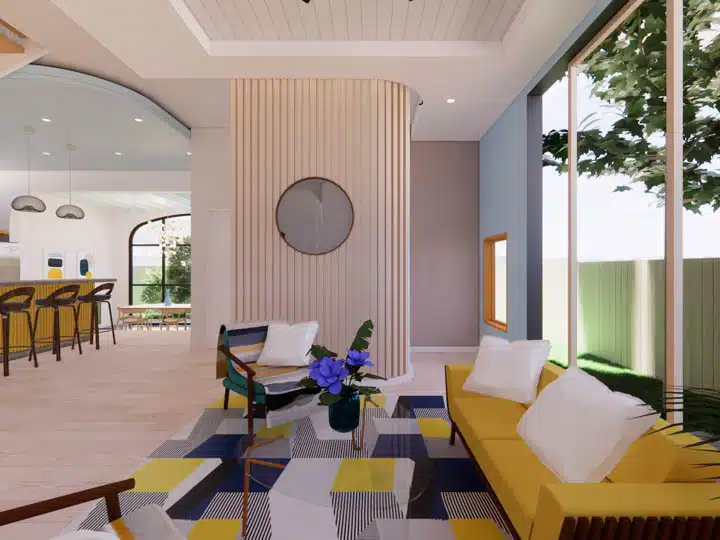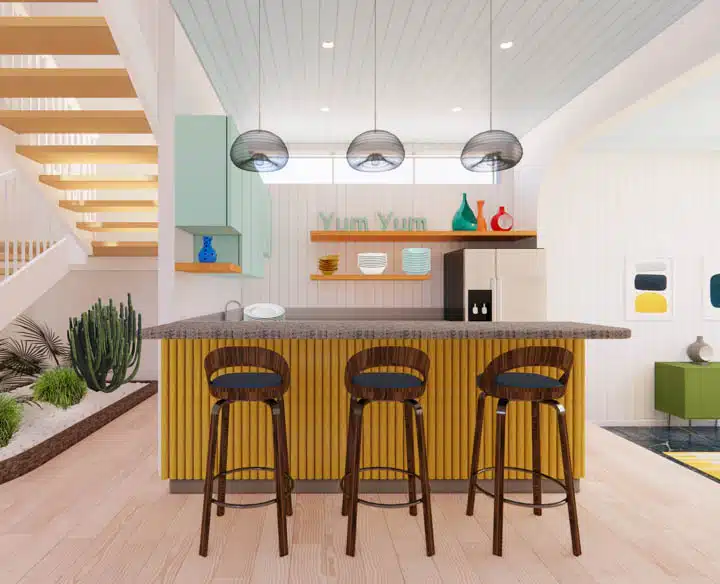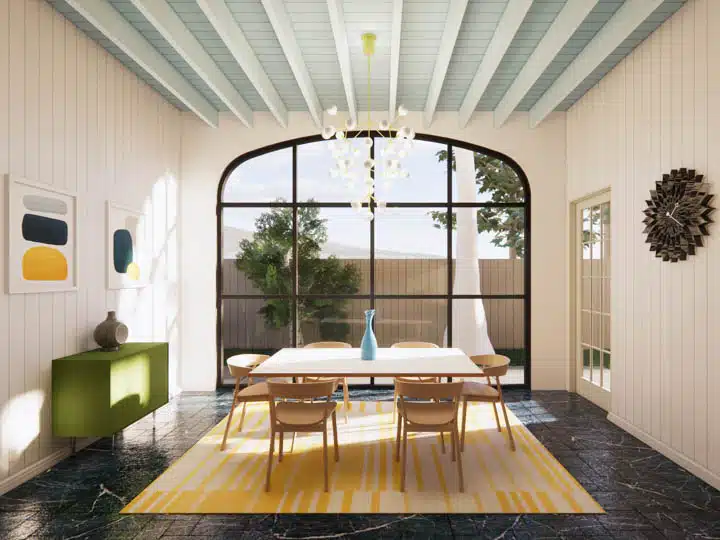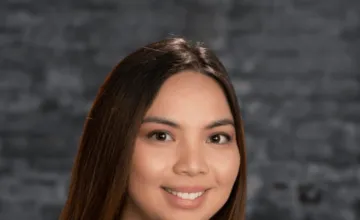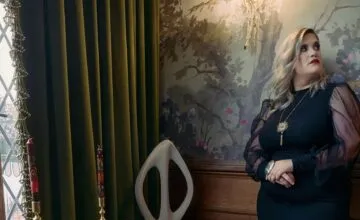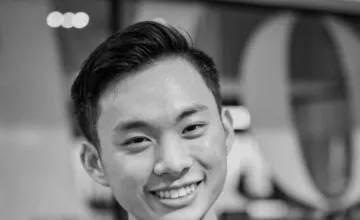Dunn-Edwards Portraits: A Tale of Two Design Competition Winners
11/01/2021 | Danielle Kinahan |
Dunn-Edwards is proud to announce the winners of our inaugural design challenge, the 2021 Emerging Professionals Design Competition: students Callie Welsh (Savannah College of Art and Design) and Helen Hoang (University of Cincinnati). While Walsh is drawn to commercial design and Hoang to residential design, both share a love of design and creativity, winning the top distinctions in their respective categories and taking home $3,000 each.
Aesthetic Inspiration from Health and Wellness
Sitting in her home in northern Vietnam, residential design winner Helen Hoang reminisces about the drastic shift COVID has had on the world of design and her University of Cincinnati design program, specifically. The student, who’s spent much of her internship time working in the health care design sector, notes, “Now there’s a focus on antimicrobial/antibacterial design, and more thought given to the space and flow between people.” Not to mention that COVID has, of course, also put an 8,000-mile distance between her and her classroom; Hoang returned to her native Vietnam after spending one semester learning virtually in Cincinnati.

But perhaps more now than ever, it’s this COVID-related shift in thinking that has helped Hoang—and other design students like her—hone in on their chosen path within the design world. Her desire is to have an impact on creating healthy living spaces in Vietnam. “COVID has required us to think about more thoughtful design for the end user,” Hoang explains. And for fellow design competition winner Callie Welsh of Savannah
College of Art and Design, this thoughtful, human-centric approach is also what excites her about a career in design. For Welsh, too, design is about more than aesthetics; it is a way to affect change in the population’s health, mood and overall wellness.

For commercial design winner Welsh, health and wellness are at the forefront of the work she aims to pursue. With a focus on lighting design, she is drawn to the role light plays in our psychology. “I think it’s so interesting that different lights and colors and different applications of lights will make a big difference in how efficient someone can be and how much work they can get done,” she explains. Ultimately, that cross-section where human behavior meets design is where Welsh wants to be.
Human-Centered Commercial Design
For her commercial design submission of a new 15,000-square-foot Dunn-Edwards warehouse and retail space in downtown San Francisco, Welsh, who hails from the Bay Area, kept the customer’s journey at the center of her design. She introduced novel ways to use technology in the paint-choosing process, such as creating a virtual reality setup for guests to envision different paint colors on their walls without first having to commit to a color or formula. In her design, Welsh also included spaces to foster community, like a workspace where professionals could host art and painting workshops, as well as a café for lounging. “Human-centered design is what I try to focus on. I like using new technology and design as an outlet to incorporate more fun in the world,” she notes. The space also includes a point-of-sale area, a product display area, and an office for Dunn-Edwards professional color consultations.
Welsh’s concept deeply rooted the commercial space in the context of its San Francisco location. She drew on the city’s character for design elements, including curves that echo the sinuous lines of the Golden Gate Bridge and the famously windy Lombard Street. She also prominently featured Dunn-Edwards 2021 Color of the Year, Wild Blue Yonder (DE5855)—a requirement in both the commercial and residential competition categories—within her site-specific color palette. From an early age, Welsh remembers being excited about art classes and participating in art camp. It’s why she doesn’t shy away from color today as an adult. In fact, her favorite Dunn-Edwards color is Spiced Berry (DEA149). “It’s muted, but it’s still colorful, and I think it can be used as a neutral in a sense,” she explains. It’s no coincidence then that the color worked its way into her design’s palette. Additional hues in the palette like Seal Pup (DE5816) and Overcast Sky (DE5821) symbolize San Francisco’s surrounding waterways and iconic fog; while Swiss Coffee (DEW341), Warm White (DEW380) and Teddy Bear (DE6131) reflect the natural tones of the region’s landscape. And red-oranges, like those found on the Golden Gate Bridge, are seen in her use of colors like her favorite, Spiced Berry (DEA149) and pops of accent colors Untamed Orange (DEA110) and Clay Pot (DE5174).
The Professional World of Design
As a master’s student at the Savannah College of Art and Design, Welsh has found fluency working with design software, whether it be CAD, Inkscape or SketchUp. She says, it’s one of the things that made a transition to online learning over the last year a bit easier. However, much like with her focus, she finds that, in education too, there’s a human-centric component that’s key and can often be missing in the virtual classroom. “It’s a lot more inspiring in a classroom,” she explains. Online classes have also made learning about interactions in the professional design world more challenging. Bridging the gap between the educational world and the professional world is something Welsh has relied on mentors for in the past. The director of the Center for Lighting Education at Welsh’s undergraduate program at Texas Christian University is one such mentor; Professor Alyssa Humphries Stewart. Welsh says the professor was helpful, in answering career-oriented questions. “It’s hard to find information online about salary, career next steps, or which tests to take to get licensed. Professor Humphries Stewart was really helpful in that regard.” The discrepancy between classroom and workplace is something Hoang, too, has noticed and is why she’s so grateful for her design program’s focus on co-ops and practical work experience. In fact, her time interning at global design firm NBBJ in Columbus, Ohio provided her insight into work life. “It showed me that even people who have been working in the industry for a long time keep learning and asking questions,” she says.
Cultural Connectedness in Residential Design
Much like for her commercial design cowinner, site context and geographical location are things that residential design winner Hoang heavily considered in her design concept, too. It all served to create a space for her imagined client that was functional, a space conducive to overall health and wellness in which a busy family could find both serenity and inspiration through their home’s layout and use of color and materials.
Hoang won for her design of a 2,000-square-foot 4-bedroom, 3-bath Mid-century Modern-style home in LasVegas, Nevada. Originally a native of Vietnam, Hoang was not instantly familiar with mid-century design nor American-style family residences when she entered the contest. To excel with her project, she immersed herself in studying both and succeeded in creating a winning design for a kind of home in which she’d never physically set foot inside.
Further, making her project a challenge was the vast difference between the way Americans use their homes versus the way Vietnamese families do. Hoang explains, for example, that American homes often possess
open floor plans—kitchens and living areas that flow freely between one another. In Vietnam, on the other hand, people prepare food away from where guests gather. There’s a clear separation between spaces. And where American homes tend to have a garden space, Vietnamese homes are usually very close to one another and typically lack exterior amenities. For Hoang, though, pursuing her true interest in residential design trumped her lack of experience. In fact, it’s that enthusiasm, which helped propel her through this challenge—and it is this advice that she wants to impart to all other design students: follow your passions. Hoang suggests starting with something you’re inspired by—and eager to practice—because, ultimately, the more you practice, the better you’re able to hone your skills. “I really liked residential design, so that is
why I was so excited to do my design, even though I had no previous experience.”
Perhaps it was in designing the unfamiliar that Hoang also found immense creative freedom. Finding joy through color is something, Hoang notes, that has drawn her to design since she was a child. Dunn-Edwards Gilded (DE5418), Hoang’s favorite color, is prominent in the winning residential design’s palette. She gushes,
“It makes me happy every time I look at it.” When it comes to the rest of her mid-century modern home’s color palette, she opted for peach, dark mustard, warm whites, cream, and pale blues and greens. Pale Jade (DE5681), Gingerbread House (DE5334), Teardrops (DE5833), Wild Blue Yonder (DE5855), Natural Tan (DE5212), Warm White (DEW380) and Milk Mustache (DE6169) were all incorporated into her project’s palette. The goal was to make her imagined client “feel relaxed and comfortable right when they step into the
house,” explains Hoang, to counteract the everyday high-pressure workload.
When it comes to her early successes in design, Hoang also points to one of her college professors at the University of Cincinnati, Professor Whitney; his patience and connection with international students, and his ability to get across an idea so simply (no matter how abstract), has created a positive learning environment, enabling her to thrive even in distance-learning conditions.
Interior Design Education in the COVID Age
Because Welsh and Hoang began their programs in 2019 and 2020, both had the extra challenge of taking classes remotely over Zoom. Learning new architectural and planning software has, of course, been
possible online, however learning about the more tactile aspects of design, like fabrics and materials, has been more difficult in an all-virtual environment. While the pandemic has been a strain on so many by upending educational studies, mental health and more, in a way, it has also helped these two design students get clarity on precisely the ways their contributions in design can help the overall mental health and wellness of their future clients.
So what’s next for the two competition winners? Well, Welsh is just recently back to on-campus learning in Savannah with her sights set squarely on the future. “I hope to become a professor and help shape the interior and lighting designers of our future,” she says. Hoang is currently exploring her next co-op opportunity in the design world and looks to bring her focus back to residential design. Dunn-Edwards hopes that the confidence that comes from winning in their respective competition categories and the $3,000 cash prize fuels their future efforts.
The 2022 Emerging Professionals Design Competition will open in March of 2022, and submissions will be due early August of 2022. Sign up for the Dunn-Edwards newsletter for a reminder on this upcoming competition and all the latest news.
Complete this form for a chance to be featured as our next Dunn-Edwards Portrait!
Featured Articles
-
 Best Oranges for the Perfect Summer Beach Cottage
Best Oranges for the Perfect Summer Beach Cottage
-
 Get Ready for Fall with These Trendy Color + Design Moods
Get Ready for Fall with These Trendy Color + Design Moods
-
 Try These Color Palettes To Nail A Tomato Girl Summer At Home
Try These Color Palettes To Nail A Tomato Girl Summer At Home
-
 Embracing Barbiecore: Popular Pinks Throughout The Ages
Embracing Barbiecore: Popular Pinks Throughout The Ages
-
 The Color Yellow: Essential Color Theory, Symbolism and Design Application
The Color Yellow: Essential Color Theory, Symbolism and Design Application







